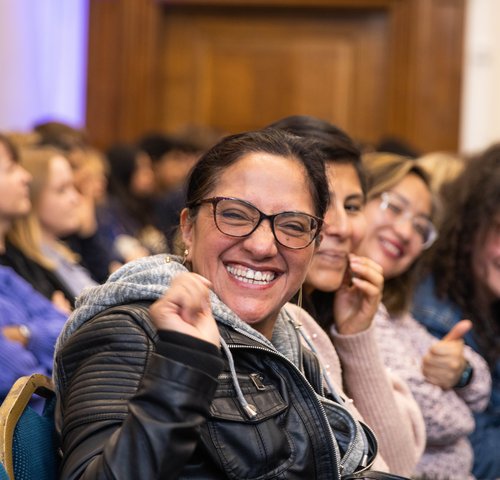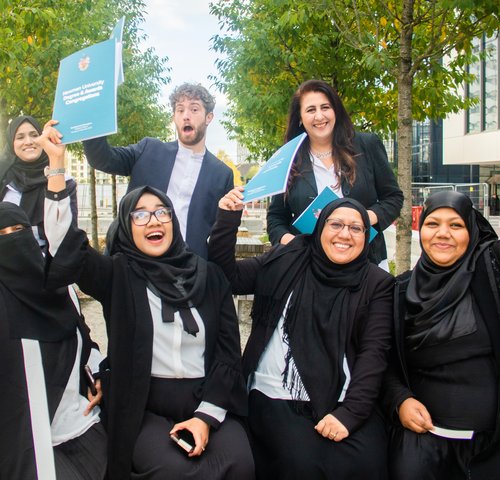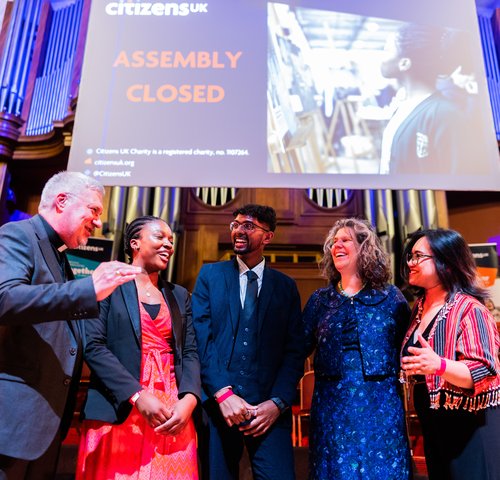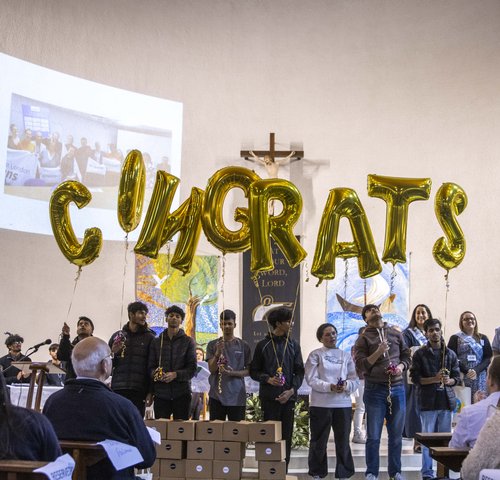Educating Young Citizens through a habit of action
Educating Young Citizens through a habit of action
-Paul Amuzie, Senior Organiser at Citizens UK
My joys, over the last eight years as a Community Organiser, have come from exploring, and engaging with, what organising looks like in schools and further education organisations. I have, over this time, started to see how, and why, organising has been so impactful on my life. In the early 2000s, thanks to the organising work that was embedded throughout my secondary school experience at St Bonaventure’s and St Angela’s, in Forest Gate, in East London, I was fortunate to see the impact that civic action could have on my life and the lives of my friends.
I fondly remember the experience I had at an inner-city boys’ school, where I was encouraged to think that there were no limits for a young man if they worked hard. My friends and I were told about careers in banking, about prestige, about success. Yet we lived in the epicentre of poverty, disadvantage, and struggling communities.
Until I was 14, my eyes were closed to my community in many ways and the disadvantages that surrounded my school were things I didn’t notice much. However, my body and mind were being suffocated by the effects of these disadvantages. I was the son of a mother who was a 70-hours-a-week working teacher. My mum raised three boys and a daughter alone, living in a council home, in Newham. As a family, we moved eleven times in seven years. Fighting poor housing conditions became part of me, whilst growing up. Fighting unsafe streets, fighting non-existent childcare and support services: all of which had a toll on me as a young person and even started to get me to disconnect from the constant rhetoric of being able to flee my East London home for the pastures of private sector and economic successes.
This was a part of me that my teachers couldn’t understand and couldn’t work out. They worried when my grades deteriorated and when my attitude started changing. Gangs descended on our school. Two of my friends got stabbed. Suddenly, the disadvantage that was a part of me could no longer be blocked out; the need for action and the need for leadership kicked in. I felt I needed to step up and come up with solutions.
My school did lots when it came to conventional things like running vigils when some of our peers got stabbed. I felt this wasn’t enough. I started to think critically about how those that had been affected by this could take action on this issue. More and more of us wanted to be part of the solution. This was crucial for me as a student who felt massively unsafe in my neighbourhood. I started to feel that the safe bubble that had protected me so far had been burst.
As students, we were encouraged to talk to each other about the particular issues we faced in our lives. Our teachers created spaces for young people to share stories and to think about the challenges we faced.
We were brought together with members from the local mosque and church to start building a team to take action on the issue of knife violence and to start building power and optimism about the changes that we could make as the people directly affected in our local area.
To think that we were able to build a team across schools, across faiths, and across generations was something I’d never considered. The impact of this organising effort at the age of 15/16 was invaluable teaching about my community and about the role I wanted to play in society.
Community Organising started making my education real. It developed me in a way that I had never experienced at school. What became apparent later on was that this had been planned intentionally by school leaders. They’d planned for this to happen so that my friends and I were explicitly taught to think about, and address, the issues we faced in our daily lives.
Our teachers had a plan for us. Our teachers planned projects for students to develop the skills and experiences needed to thrive in a world that was full of difficult issues. They developed learning opportunities where people from different backgrounds and cultures got together to try to work together in an ever-changing society, getting us all to realise that we could all learn to listen to each other and work together on issues of shared interest. Our teachers enabled us to become active citizens.
I am eternally grateful to Sir Michael Wilshaw, my Headteacher at the time, and to Delia Smith for the vital parts they played in making this happened and for the way they placed a huge emphasis on this kid of work.
ARK ACADEMY’S BUS CAMPAIGN
Organising had moved me at school and this experience was one that fuelled my focus organising in educational establishments. Delia Smith, an experienced educator with over 40 years in education, paved the way for how organising could be, and should be, a pillar of the culture in schools. She spent her time in East London as a founding member of The East London Communities Organisation (TELCO, the founding chapter of London Citizens). She was the first headteacher to go from UK on the Industrial Areas Foundation 10-day National Training. The impact it had on her quickly became very clear: it shaped the way she wanted to develop young people and shape her school community.
At St Angela’s – Delia Smith’s first headship – I had the privilege of learning about how she had morphed the Ursuline mantra of ‘Serviam’ and how she had created a culture that was embedded in the spine of the school: one of service to community. She established ways to grow young people with a stronger sense of community. She was intent on making sure students played a vital role in their community. She ensured students were taught to listen, understand, and act.
'Serviam’ was the driving force for getting the students of St Angela’s to address the common issues we all faced across our neighbourhood. A deprived area that lacked skilled work opportunities and living wages. Many of the young people from St Angela’s were – and still are – from Black African and Caribbean descents and were not in need of work and a good wage yet but such issues certainly affected their families and neighbours. This therefore became something interesting to think about in terms of how the Ursuline motto of ‘Serviam’ could be brought to life.
I was privileged enough to work with Delia Smith again but, this time, as an employee. Delia had moved to North London to embark on a new journey. As she became the Founding Principal of Ark Academy, Delia Smith had the opportunity to build a new school – and its culture – from scratch. Initially, this new school was promised to students of the massively deprived communities of Church Road, St Raphael’s, and Stonebridge, all located in one of the most deprived areas of London. However, as the Department for Education couldn’t find a site for the school, it eventually got located in the heart of the bustling – and much more affluent – Wembley, home of the National football stadium and next to a brand-new housing development.
Delia set out again to lay the groundwork to enable her to bring in the cultures and principles of organising into a language that teachers, parents, and students of this new school community could understand without any prior knowledge of what this was about. Using what she had learnt and developed at St Ursula’s, she created a new ‘Serviam’: one that was secular and shaped to be accepted by all. ‘Civitas’ became the key work, one that would embody her vision of what citizenship would look like through the school and its community, as well as the structures that would enable the development of active citizens to take place. ‘Civitas’ became the basis for all members of the school community to commit to actively participate in civic life: to be actors in a society and create positive change.
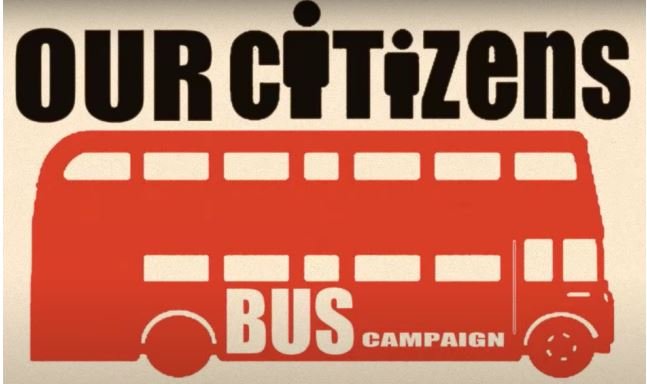
As the school was intended to serve an area located over two miles away from its actual site, it soon became clear that some clear logistical challenges would surface. In 2014, as we did a large listening campaign, involving 90% of the school community, we started making a list of the issues we felt needed to be addressed.
With a wide range of results, it became clear that there was a lot we could get involved in: poor housing and overcrowded homes, a lack of jobs and living wages on the Wembley development, worries of unwelcoming environments for the large number of new migrants coming and living in Brent, and many other issues.
Amongst all these issues, the one that connected all the different parts of the school community was the lack of adequate transport provision: there were not enough buses and when buses did come, they were always congested. This led to students being delayed in the morning, or arriving home late, impacting home life – not to mention homework time!
We built and trained a team of over 25 students and started to embark on whether this issue affected other schools in the local area. Unsurprisingly, it did. Crest Academy, not far from Ark Academy, also got involved. As well as facing the same issues, students from both schools realised that such poor transport conditions led to conflicts between them.
This issue was very specific, it was unifying, and, if resolved, we felt it could really improve outcomes for students constantly getting in trouble. Our next step was to get hard evidence. We had to research the issue further and get more facts. Our team of 25 students met weekly for a hour: that gave us plenty of time to properly carry out our research.
Samir, Victoria, Sammy and Anab led our group: for six weeks, we went out to the bus stops and counted the amount of pupils getting on and off the bus. We timed intervals between buses and counted how many students were being left to stand – sometimes for hours – at the bus stops after school.
We sought to show teachers and parents how arduous bus journeys were: we came up with a ‘show a teacher your journey’ strategy. Ms Houri, a Mathematics teacher who didn’t understand, at first, why Sammy, who lives on the St Raphael’s Estate was so late in the morning, soon realised that there were reasons why that was the case. Ms Houri became involved and, seeing the other side, she was also committed to getting other teachers to understand and get behind the campaign.
Buses 182 and 206 were the main offenders! They were the ones we needed to sort out. The 206 bus went all around Brent and therefore took over ninety minutes to get from the estates to school when, if it had been more direct, would only have taken about twenty-five minutes. Bus 182 was a double decker, but went past too many schools and, therefore, was constantly overcrowded at the beginning and end of the school day.
Both buses were operated by Metrolink and our team decided we should go to the Willesden Bus Garage where both buses originated. We wanted to meet Mr Steve, the Metrolink Manager.
We planned and organised a day of action. Students, during their Tutor Time, at the start of the day, spent some time drawing hands and writing inside about their experience of buses in Brent. We stuck 500 hands on a huge red bus that we made out of sugar paper. We then made our way to Willesden in the afternoon. 60 students and 10 teachers met Mr Steve and his bus drivers. We held conversations with all of them, and shared stories about our experiences on the buses. Two members of our team strode into the garage office to presented Mr Steve with a letter with our findings and our asks. The pride on these students’ faces, as well as the enjoyment of being listened to by the bus drivers that drove them to school and back home every day, was palpable.
Sadly, nothing changed straight after this action: Mr Steve had no power to do anything. We went back to the drawing board after months of research. The crucial lesson, through this process, was that you don’t always win: not every action leads to the desired conclusion. What we’d managed to do, however, was to build our capacity to take action. We’d also built loads of relationships and, as such, increased our power.
At this stage of our campaign, I remember Samir (a young leader who had been involved in this work from its inception at school) revealed to the team that we should focus on Boris Johnson. ‘Boris is the man!’, Samir kept saying.
We started doing our ‘power analysis’ more carefully, working out who controlled the transport system we wanted to influence. We now knew that the man who ultimately had the power to affect change on issues relating to Transport in London was its very Chairman: Boris Johnson, the then Mayor of London. We had to work our way to Mr Johnson: thus, we started to build relationships around him, getting closer and closer to him. We did more research to find out that the person who could help make decisions on this was Leon Daniels, the Managing Director of Service Planning for Transport for London.
We weren’t powerful to get to Leon Daniels by ourselves, so we built relationships with other young people across London struggling with buses. We worked with a sixth form college in South London (SFX) and they helped us make a video letter to Leon Daniels personally. Our video polarised the issue: we wanted to make it clear that Leon Daniels could either be in complete agreement with us or in complete opposition. Making things clearly polarised help build some useful tension. Teaching our team of young people about how to you personalise an issue to get a response from a human person rather than an organisation, we made it clear that this was no longer about Transport for London and its buses. Rather, it was about Leon Daniels. It was about Leon Daniels being responsible for making young people travel late in the dark winter months, when all they wanted was to be home in time to eat and do their homework.
We sent our video letter to Leon Daniels. He didn’t respond for months.
The students and the schools were hugely disappointed: they had taken a month to make their 7-minute video and they had failed to get the reaction they were looking for. I will never forget Sammy and how angry he felt, every week, as he came after school on Thursdays to our session. He’d be greeted with to chorus of ‘Sammy, Leon Daniels still hasn’t responded!’. This led to Sammy shouting and stomping around. He was so angry. His anger was real. He lived in St Raphael’s and wanted change.
The team soon wanted more action. We started to plan for another attempt. We felt it was time we went to Transport for London’s head office.
The team lobbied Delia Smith and Carla Haslam, one of Delia’s Smith’s Vice Principals. ‘Could we get 100 students across London to Southwark and take our asks directly to Leon Daniels?’ was our request. The answer, thankfully, was a resounding ‘Yes’.
We redoubled our efforts and came up with the slogan ‘We are tired of waiting, Leon!’. And we were! We were tired of waiting all evening for buses and waiting for Leon Daniels to respond and do something about the situation.
Our team shared the message with the school community, along with our plan which included to go to Transport for London’s Head Office wearing pyjamas! We had been on this journey for 15 months by then, and we were not going to give up. Many students wanted to join this action. It was the hottest ticket in town. Everyone wanted to be part of the team that would descend on Boris Johnson and Leon Daniels, ready to pack a metaphorical punch. The day before the action, we were able to get on BBC London News at 7 o’clock in the morning. Ms Haslam and Victoria, a Year 9 leader part of our group, told the story and gave the threat of action to 2 million London listeners: ‘We are coming today to tell Leon Daniels that we are tired of waiting!’. By the afternoon, Transport for London had tweeted the school: ‘Don’t come. Instead, we will have a meeting at your school to discuss solutions.’ They had finally responded. We had them in our grasp.
The next day, we still decided to go: we had to show them our power. Sammy was ready. We were all ready.
100 students and 20 members of our alliance in Brent were ready. One of our local Councillors – Cllr Robert Johnson – was ready. A local vicar – Reverend Maggie Hindley – was ready. Together with our young people, our united neighbours were ready to make a stand. We travelled on the train: so many fellow passengers asked our young people what they were doing and everybody was astounded to realise they were taking action. People were impressed by the students’ seriousness, tenacity, clear vision, as well as their sense of anger. We reached Bermondsey Station and we got off. We decided to stop one stop early so we could march to the Head Office with our megaphone and the chant we had prepared.
Why are we waiting?... We are tired of waiting!... We have homework to do and parents to see!... Why are we waiting?...
We finally arrived at Transport for London’s Head Office. Our 100 citizens were met by security guards at every corner. The team was shocked. We are here in pyjamas and we were met by security guards, refusing to let us in. Finally, after minutes of confusion and refusal to go away, Leon Daniels emerged in the flesh. We had a delegation ready to greet him and shake his hand. Soon, students shared their well-rehearsed testimonies. To our surprise, Leon Daniels decided to invite everyone in.
As we got inside, Samir and Anab shared our work, more testimonies, as well as our asks. Leon Daniels gratefully received the message and agreed to make the changes necessary. He agreed to send his Head of Bus Operations to meet with us at school to discuss the exact details of what should be done. We set a date and took pictures.
Six weeks later, after a few sessions evaluating the work we’d carried out, we felt we could celebrate.
We had increased the frequency of buses at peak school times for both routes and it was agreed that a new shorter route would be devised in the coming year.
We won. After almost 18 months of listening, research, team building, actions and evaluating, we had won! This story is part of the fabric of the school. The journey for those that were part of the team was invaluable and the change for the school was clearly noticeable.
The important thing, though, was that this was one of the many stories that shaped the culture of the school. A habit of action became part of every student’s education.
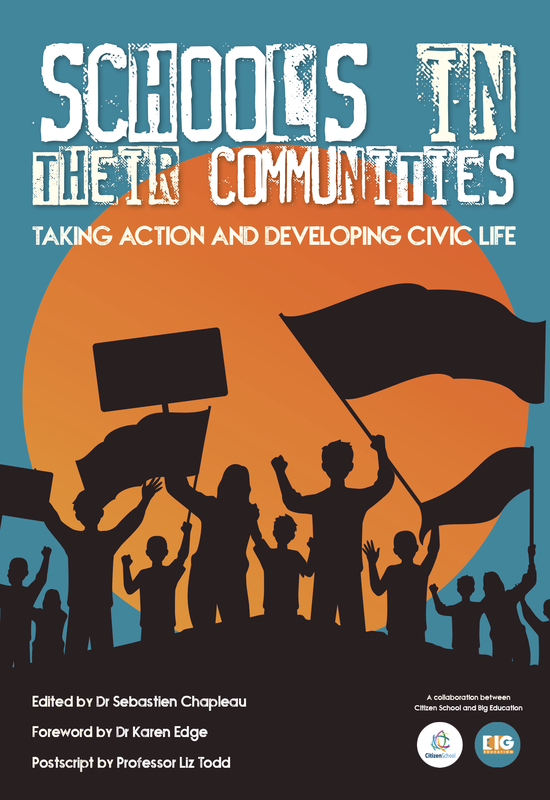
Schools in their Communities
This is an extract from Schools in their Communities; Taking action and developing civic life by Sebastien Chapleau.
Click below to download your free e-book and read more case studies on schools involved in Community Organising
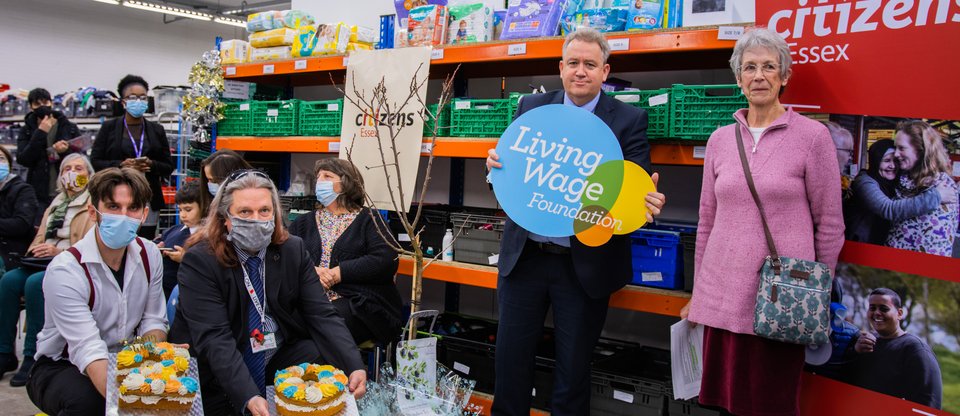
Citizens UK is made up of hundreds of member organisations that are committed to taking action together for social justice and the common good.
We believe that faith, education, trade union and community organisations play a vital role as civil society institutions with deep and long-standing roots in their local areas. Through voluntary participation in these organisations, people build relationships, trust, vision and hope - and learn how to work constructively with those they might disagree with, to focus on what they have in common.
